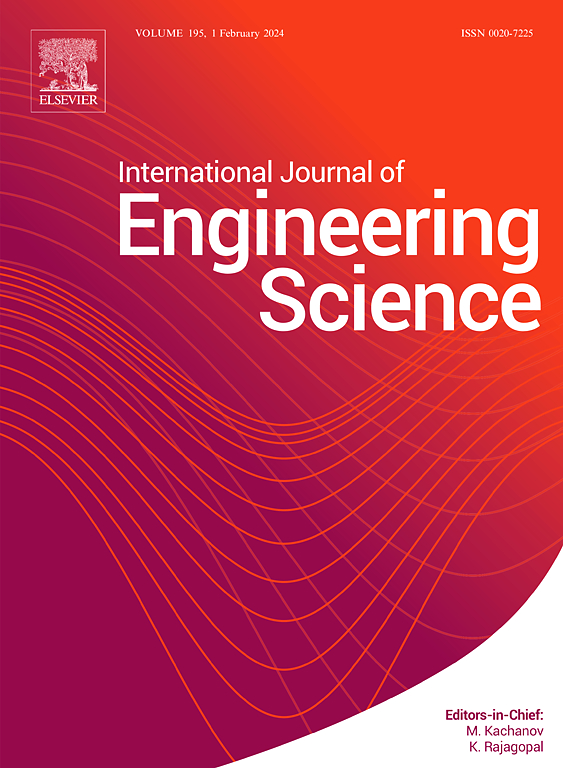A well-posed theory of linear non-local elasticity
IF 5.7
1区 工程技术
Q1 ENGINEERING, MULTIDISCIPLINARY
International Journal of Engineering Science
Pub Date : 2025-06-18
DOI:10.1016/j.ijengsci.2025.104314
引用次数: 0
Abstract
We address ill-posedness of Eringen’s non-local theory of elasticity, as a result of the implicit presence of boundary conditions, termed constitutive (CBCs), embedded in the choice of the attenuation function (kernel). Such CBCs supplement the natural boundary conditions of the problem, hence the problem becomes overdetermined and, almost inevitably, ill-posed. Although this feature is true in general, it is especially manifest when the kernel is the Green function of a differential operator. To guarantee well-posedness for any loading, we propose a method by which the kernel is modified only in terms of the CBCs, which are selected to coincide with the natural boundary conditions of the problem. Taking the Helmholtz kernel as an example, we show that, after modification, the self-adjoint character of the integral operator is preserved, which guarantees that the attached elastic energy is a (positive definite) quadratic functional. By eigenfunction expansion of the kernel, we prove, through some examples, that the results obtained from the differential formulation correspond to those given by the integral problem, a result largely disputed in the literature. Along the process, we explain the inevitable appearance of scenarios, sometimes named paradoxes, which lead to solutions that match those of local elasticity. This outcome simply emerges whenever any particular problem produces a local curvature field which matches one of the kernel’s eigenfunctions and it is in no way connected with the problem of the CBCs. Given that the modified kernel remains close to the original kernel away from the boundaries, results correspond to Eringen’s in the limit of an infinite domain. Comparison is also made with respect to the Two Phase Non-local Model (TPNM), that also warrants well-posedness for any load and yet, in contrast to this approach, requires extra nonphysical boundary conditions.
线性非局部弹性的适定理论
我们解决了Eringen的非局部弹性理论的不适定性,由于隐式存在的边界条件,称为本构(CBCs),嵌入在衰减函数(核)的选择。这样的CBCs补充了问题的自然边界条件,因此问题变得过度确定,并且几乎不可避免地成为病态的。虽然这个特征在一般情况下是正确的,但当内核是微分算子的格林函数时,它尤其明显。为了保证任何负载的适定性,我们提出了一种方法,该方法仅根据CBCs对核进行修改,这些CBCs被选择为与问题的自然边界条件相一致。以Helmholtz核为例,证明了修正后的积分算子保持了自伴随性质,保证了所附弹性能是一个(正定)二次泛函。通过核的特征函数展开,我们通过一些例子证明了由微分公式得到的结果与由积分问题得到的结果相对应,这一结果在文献中有很大的争议。在这个过程中,我们解释了不可避免的场景出现,有时被称为悖论,这导致了与局部弹性相匹配的解决方案。这个结果只是出现在任何特定的问题产生一个局部曲率场,它匹配核的特征函数之一,它与CBCs的问题没有任何联系。假设修改后的核在远离边界的地方与原核保持接近,则结果在无限域的极限处对应于Eringen’s。还与两相非局部模型(TPNM)进行了比较,该模型也保证了任何负载的适定性,然而,与此方法相反,需要额外的非物理边界条件。
本文章由计算机程序翻译,如有差异,请以英文原文为准。
求助全文
约1分钟内获得全文
求助全文
来源期刊

International Journal of Engineering Science
工程技术-工程:综合
CiteScore
11.80
自引率
16.70%
发文量
86
审稿时长
45 days
期刊介绍:
The International Journal of Engineering Science is not limited to a specific aspect of science and engineering but is instead devoted to a wide range of subfields in the engineering sciences. While it encourages a broad spectrum of contribution in the engineering sciences, its core interest lies in issues concerning material modeling and response. Articles of interdisciplinary nature are particularly welcome.
The primary goal of the new editors is to maintain high quality of publications. There will be a commitment to expediting the time taken for the publication of the papers. The articles that are sent for reviews will have names of the authors deleted with a view towards enhancing the objectivity and fairness of the review process.
Articles that are devoted to the purely mathematical aspects without a discussion of the physical implications of the results or the consideration of specific examples are discouraged. Articles concerning material science should not be limited merely to a description and recording of observations but should contain theoretical or quantitative discussion of the results.
 求助内容:
求助内容: 应助结果提醒方式:
应助结果提醒方式:


